

Shy and shrouded in mystery, Pink River Dolphins live within the remote Amazon and Orinoco River systems in several South American countries, making them even more intriguing. Hard to spot by the untrained eye, travellers need to visit the precise location with a knowledgeable guide.
The pink color is due to a genetic mutation called albinism, which is a recessive trait that happens only if the mutated genes were received from both parents. According to Blue World Institute, there have only been about 20 recorded sightings since the mid-20th century.
While they are known to be shy creatures, they are fascinatingly drawn to people, playing curiously with local children, and without demonstrating aggressive behavior. They also communicate using high-frequency sonar clicks to build a three-dimensional echogram of their dark riverine world.
A pink dolphin is actually a mythical creature among Indigenous people. The pink dolphin is a talisman of good luck, and killing one will bring you death or bad luck depending on which folktale you are reading.
Pink dolphins spotted with baby from completely different species in 'mystery' encounter in Cambodia Live Science - June 13, 2024
A rare, endangered baby dolphin has been spotted swimming with members of a different species in Cambodia, leaving scientists puzzled. The Irrawaddy dolphin (Orcaella brevirostris) calf was likely with its mother in a group of Indo-Pacific humpback dolphins (Sousa chinensis). Irrawaddy dolphins are dark gray with squished faces, while Indo-Pacific humpback dolphins are pink with long noses, so the calf and mother stuck out like saw thumbs.
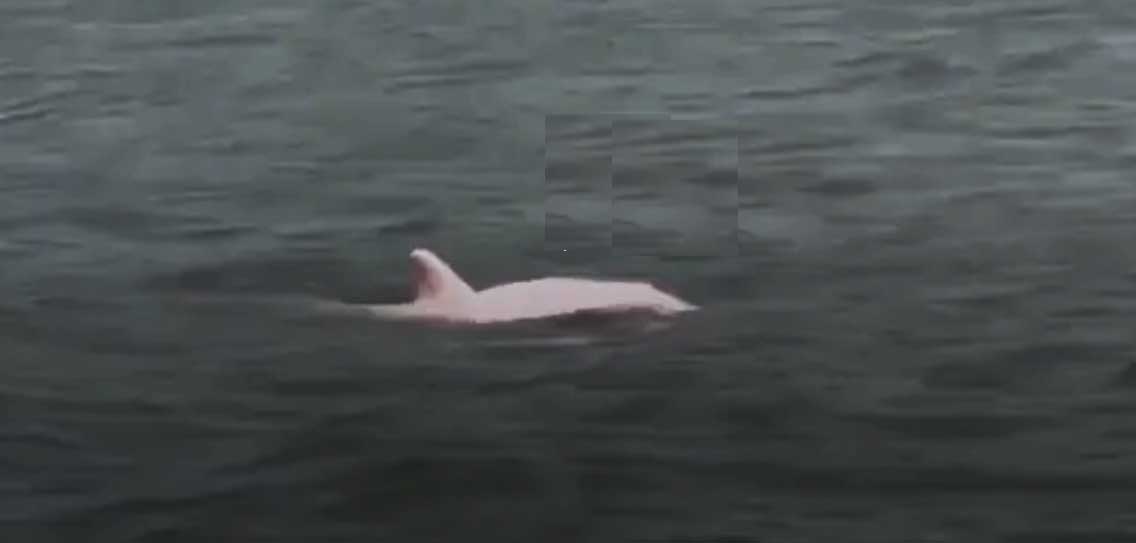
Video: Pink Dolphin Spotted Off Louisiana Coast Weather.com - July 19, 2023
A pink dolphin that could be a rare albino bottlenose was spotted by a fisherman off the coast of Cameron, Louisiana.
Dolphins are majestic mammals of the ocean. They have fascinating personalities and can live up to 90 years, making over 1,000 clicking sounds in under 1 second despite having no vocal cords.
These beautiful creatures are intelligent, agile, joyful, and playful animals that share many emotional similarities with humans. But what do dolphins symbolize?
Dolphins are often seen as saviors and protectors of life and harmony. They represent pureness and play, as well as honor and protection.
Known for their playful personalities, dolphins are all about having fun and doing what sparks joy. Due to this duality of dolphins (their playful side and their protective side), the dolphin represents us living our true purpose and reaching fulfillment.
At their core, dolphins symbolize help, guidance, messages, intelligence, fun, joyfulness, freedom, teamwork, transformation, and psychic abilities.
Dolphins are often considered good omens, especially to sailors. Plenty of sailor tales involve being saved by the beautiful sea creatures, protecting the sailors after being swept away at sea. If you encounter or even see a dolphin in person, it is a sign of good fortune coming your way in the near future.
According to Chinese folklore, a white dolphin is a positive omen. They symbolize following one's intuition and staying on the right path.
A black dolphin symbolizes transformation as well as new beginnings. These dolphins represent the cycle of life and death along with how we all go through both.
Blue dolphins are also known as good omens, symbolizing hope and a new life.
Dreaming of a dolphin in the water is a good omen. It means that your communication with people is excellent, and it is an encouraging sign to meet new people.
This dream signals harmony and balance. A dream about a pod of dolphins also symbolizes that a content life is ahead, as well as an omen meant for you to trust others.
A dream of riding this creature is one of the highest spiritual dreams of dolphins. It means that you wish to gain higher spiritual knowledge and bring your mind to its greatest ability.
Dreaming of feeding a dolphin symbolizes that you have gained great experiences you will find incredibly useful in the future. It signifies good luck, great news, and stupendous happiness.
Dreaming of a talking dolphin encourages you to take on more values and fight for your passions. Dreaming of a talking dolphin suggests you should get involved with global awareness and strengthen your worldly knowledge.
Dreaming of dolphins chasing you indicates that you are closed off to life and need to be more open. If a dolphin is chasing you, you need to start taking chances in life and live to your full potential.
There are two popular interpretations of a dream about killing a dolphin. The first is that your relationship will be happy and harmonious. The other is that you will undergo a very bitter fight with a friend, family member or loved one.
Dreaming of a flying dolphin symbolizes youth and happiness. It is a child's dream at best since dolphins cannot fly, signaling that your inner child wants to come out and play. So, it would be wise of you to let it.
This dream is a good sign. Swimming with dolphins in a dream symbolizes harmony and excitement, and that your days are happy due to your natural optimism.
Spirit animals are guides who help us stay on the right path in life, also teaching us lessons as we go on. Similarly, though very different, totem animals are guides, but they only assist us when we invoke them during difficult times.
While you cannot choose your spirit animal, you'll know if you have a dolphin as a spirit animal if you resonate with them in some way or have had a profound experience with one in the past.
Those with a dolphin spirit animal are known to be incredibly playful, happy, intelligent, and carefree. They are often seen surrounded by people because they are well-liked and their positive energy is contagious. They are light-hearted but have a strong sense of intuition.
People who have a dolphin as a spirit animal also have a protective side to them. They go to bat for their loved ones in a heartbeat and defend their friends and family. They are drawn to bodies of water and usually try to work on themselves to become better in any way they can.
A dolphin spirit animal needs to learn that it's okay to want to venture out on its own and doesn't always need to be connected to a place or people. Though dolphins swim in pods, they also value freedom and have an adventurous spirit.
A dolphin totem is called upon when you need guidance in a decision or require help in a difficult position. The dolphin totem should give you wisdom and clarity and spiritually guide you in the right direction.
Three year old Allie Keys - a hybrid child (human and alien) commanding the Dolphins
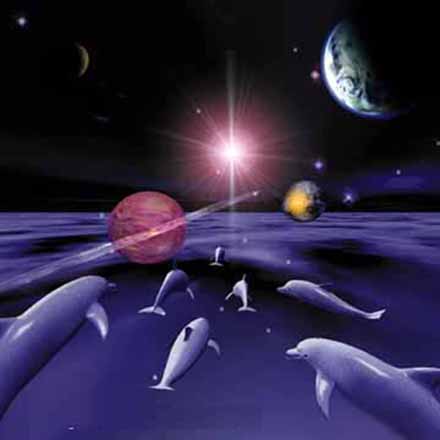

Some believe there are dolphin frequencies that connect Earth with Jupiter's moon, Io. Allegedly aliens travel back and forth between Io and Earth through underwater portals - taking dolphin form on Earth. They use their energies and harmonics to balance the planet.

My friend Paul lived in Hawaii for 30+ years, studying healing and doing energy work alone or with others. Most days he swims with the dolphins, who he says speak to him by sounds or telepathically. It means Paul's brain connects to their frequencies and his brain interprets the messages.
Paul reports that in recent years messages have changed, intuitively telling him that great change is about to happen not only where he lives, but everywhere on the planet, as witnessed by the increase in natural disasters and climate change.
Other friends who work and swim with dolphins, also pick up messages of great cataclysmic changes that are coming.

Animal-assisted therapy (AAT) is a type of therapy that involves animals as a form of treatment. The goal of AAT is to improve a patient's social, emotional, or cognitive functioning. Advocates state that animals can be useful for educational and motivational effectiveness for participants. A therapist who brings along a pet may be viewed as being less threatening, increasing the rapport between patient and therapist Animals used in therapy include domesticated pets, farm animals and marine mammals (such as dolphins). While the research literature presents the relationship between humans and companion animals as generally favorable, methodological concerns about the poor quality of the data have led to calls for improved experimental studies.
Dolphin assisted therapy (DAT) is an alternative medicine/therapy option for people who do not respond or are not keen on traditional medicines/therapies and it is a controversial therapy. John Lilly, who studied dolphin-human interaction, first considered this idea that interactions with dolphins can have rewarding benefits on humans in the 1960s. David Nathanson, who was a clinical psychologist, came up with much of the existing research on this therapy today. Nathanson's theory was that children with disabilities would increase their attention to related stimuli in the environment in hopes they would get to interact with the dolphins, helping motivate the child to do the task at hand and to give the appropriate responses according to that child's therapy program lessons
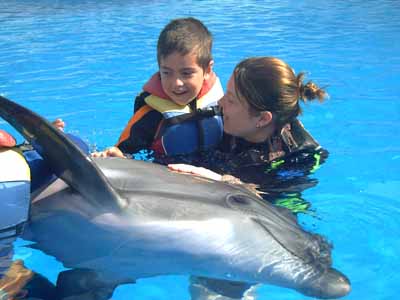
Dolphins often show a fondness for young children. Sometimes when a child enters a pool dolphins, they are immediately surrounded by attentive females. Working with dolphins has had positive results with autistic children and others with 'special needs'. The research continues. Dolphin assisted therapy's agenda focusing on children with autism, Down syndrome, and Cerebral Palsy with rehabilitation in motor function, speech, and language, and attention span.

Dolphins combat child deafness BBC - August 3, 2000
An innovative treatment for deafness in children involving dolphins. One by one, the children remove their hearing aids and wait for a dose of musical medicine. At the command, dolphins Raddy and Grand burst into song. It might not sound the most relaxing melody - but to the deaf children it is, quite literally, music to their ears. Suddenly, these children can hear sounds and noises that usually they are unable to detect.
Dolphins in the Pacific Ocean are perhaps a
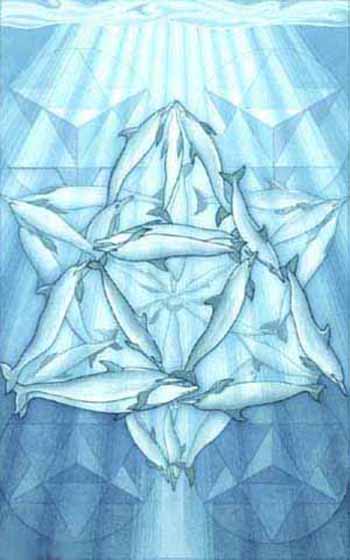
connection to the mythical continent of Lemuria.
Dolphins were important to the Minoans,

judging by artistic evidence from the palace at Knossos.
Dolphins appear in a number of Greek myths, invariably as helpers of humankind.
A dolphin rescued the poet Arion from drowning and carried him safe to land, at Cape Taenarum, now Cape Matapan, a promontory forming the southernmost point of the Peloponnesus. There was a temple to Poseidon and a statue of Arion riding the dolphin. (Herodotus I.23; Thucydides I.128, 133; Pausanias iii.25, 4)
The Greeks reimaged the Phoenician god Melqart as Melikertes (Melicertes) and made him the son of Athamas and Ino. He drowned but was transfigured as the marine deity Palaemon, while his mother became Leucothea. (cf Ino.) At Corinth, he was so closely connected with the cult of Poseidon that the Isthmian Games, originally instituted in Poseidon's honor, came to be looked upon as the funeral games of Melicertes.

Phalanthus was another legendary character brought safely to shore (in Italy) on the back of a dolphin, according to Pausanias. Many clay seals and old coins depict a man or boy riding a dolphin.
Dionysus was once captured by Etruscan pirates who mistook him for a wealthy prince they could ransom. After the ship set sail Dionysus invoked his divine powers, causing vines to overgrow the ship where the mast and sails had been. He turned the oars into serpents, so terrifying the sailors that they jumped overboard, but Dionysus took pity on them and transformed them into dolphins so that they would spend their lives providing help for those in need.
Dolphins were also the messengers and helpers of Poseidon, Greek god of the sea. Dolphins were sacred to both Aphrodite and Apollo.

In Hindu mythology the Ganges River Dolphin is associated with Ganga, the deity of the Ganges river. The dolphin is said to be among the creatures which heralded the goddess' descent from the heavens and her mount, the Makara, is sometimes depicted as a dolphin.
The Boto dolphins in the Amazon River are shapeshifters, or encantados, who are capable of having children with human women.
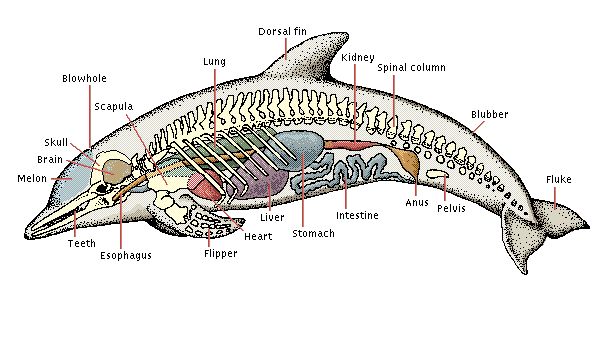
Dolphins are marine mammals that are closely related to whales and porpoises. There are almost forty species of dolphin in seventeen genera. They vary in size from 1.2 metres (4 ft) and 40 kilograms (88 lb) (Maui's Dolphin), up to 9.5 m (30 ft) and ten tonnes (the Orca or Killer Whale). They are found worldwide, mostly in the shallower seas of the continental shelves, and are carnivores, mostly eating fish and squid. The family Delphinidae is the largest in the Cetacea, and relatively recent: dolphins evolved about ten million years ago, during the Miocene. Dolphins are considered to be amongst the most intelligent of animals and their often friendly appearance and seemingly playful attitude have made them popular in human culture.
Dolphins do not whistle, but instead "talk" to each other using a process very similar to the way that humans communicate, according to a new study. While many dolphin calls sound like whistles, the study found the sounds are produced by tissue vibrations analogous to the operation of vocal folds by humans and many other land-based animals.
Dolphins are capable of making a broad range of sounds using nasal airsacs located just below the blowhole. Roughly three categories of sounds can be identified: frequency modulated whistles, burst-pulsed sounds and clicks. Dolphins communicate with their whistles and burst-pulsed sounds, though the nature and extent of that ability is not known. At least some dolphin species can identify themselves using a signature whistle. The clicks are directional and are for echolocation, often occurring in a short series called a click train. The click rate increases when approaching an object of interest. Dolphin echolocation clicks are amongst the loudest sounds made by marine animals.
Dolphins emit pulses of sound from the melon, a fatty area just below the blowhole. Much like the orientation vocalizations of a bat, these pulses, or clicks, return as echoes when the sound bounces off objects in the dolphin's path. The animal uses the echoes to navigate and to judge the distance to, and location of, prey as small as shrimp. Dolphins also produce whistling sounds when excited or communicating with other dolphins. These sounds arise from the larynx.
Dolphins almost constantly emit either clicking sounds or whistles. The clicks are short pulses of about 300 sounds per second, emitted from a mechanism located just below the blowhole. These clicks are used for the echolocation of objects and are resonated forward by the so-called oily melon, which is located above the forehead and acts as an acoustic lens. Echoes received at the area of the rear of the lower jaw are transmitted by a fat organ in the lower jaw to the middle ear. This echolocation system, similar to that of a bat, enables the dolphin to navigate among its companions and larger objects and to detect fish, squid, and even small shrimp. The whistles are single-toned squeals that come from deeper in the larynx. They are used to communicate alarm, sexual excitement, and perhaps other emotional states.
Because of the ability of dolphins to learn and perform complex tasks in captivity, their continuous communications with one another, and their ability, through training, to approximate the sounds of a few human words, some investigators have suggested that the animals might be capable of learning a true language and communicating with humans. Most authorities, however, agree that although the dolphin's problem-solving abilities put the animal on an intelligence level close to that of primates, no evidence exists that dolphin communications approach the complexity of a true language.
Most dolphins have acute eyesight, both in and out of the water, and they can hear frequencies ten times or more above the upper limit of adult human hearing.
Though they have a small ear opening on each side of their head, it is believed hearing underwater is also, if not exclusively, done with the lower jaw, which conducts sound to the middle ear via a fat-filled cavity in the lower jaw bone. Hearing is also used for echolocation, which all dolphins have.
Dolphin teeth are believed to function as antennae to receive incoming sound and to pinpoint the exact location of an object.
The dolphin's sense of touch is also well-developed, with free nerve endings densely packed in the skin, especially around the snout, pectoral fins and genital area. However, dolphins lack an olfactory nerve and lobes, and thus are believed to have no sense of smell.
They have a sense of taste and show preferences for certain kinds of fish. Since dolphins spend most of their time below the surface, tasting the water could function like smelling, in that substances in the water can signal the presence of objects that are not in the dolphinÕs mouth.
Though most dolphins do not have hair, they do have hair follicles that may perform some sensory function.
The small hairs on the rostrum of the Boto river dolphin are believed to function as a tactile sense possibly to compensate for the Boto's poor eyesight.
Dolphins are often regarded as one of Earth's most intelligent animals, though it is hard to say just how intelligent. Comparing species' relative intelligence is complicated by differences in sensory apparatus, response modes, and nature of cognition. Furthermore, the difficulty and expense of experimental work with large aquatic animals has so far prevented some tests and limited sample size and rigor in others. Compared to many other species, however, dolphin behavior has been studied extensively, both in captivity and in the wild.
Dolphins are social, living in pods of up to a dozen individuals. In places with a high abundance of food, pods can merge temporarily, forming a superpod; such groupings may exceed 1,000 dolphins. Individuals communicate using a variety of clicks, whistles and other vocalizations. They make ultrasonic sounds for echolocation. Membership in pods is not rigid; interchange is common.
However, dolphins can establish strong social bonds; they will stay with injured or ill individuals, even helping them to breathe by bringing them to the surface if needed. This altruism does not appear to be limited to their own species however. The dolphin Moko in New Zealand has been observed guiding a female Pygmy Sperm Whale together with her calf out of shallow water where they had stranded several times. They have also been seen protecting swimmers from sharks by swimming circles around the swimmers or charging the sharks to make them go away.
Dolphins also display culture, something long believed to be unique to humans (and possibly other primate species). In May 2005, a discovery in Australia found Indo-Pacific bottlenose dolphins (Tursiops aduncus) teaching their young to use tools. They cover their snouts with sponges to protect them while foraging. This knowledge is mostly transferred by mothers to daughters, unlike simian primates, where knowledge is generally passed on to both sexes. Using sponges as mouth protection is a learned behavior.[27] Another learned behavior was discovered among river dolphins in Brazil, where some male dolphins use weeds and sticks as part of a sexual display.[28]
Dolphins engage in acts of aggression towards each other. The older a male dolphin is, the more likely his body is to be covered with bite scars. Male dolphins engage in such acts of aggression apparently for the same reasons as humans: disputes between companions and competition for females. Acts of aggression can become so intense that targeted dolphins sometimes go into exile as a result of losing a fight.
Male bottlenose dolphins have been known to engage in infanticide. Dolphins have also been known to kill porpoises for reasons which are not fully understood, as porpoises generally do not share the same diet as dolphins, and are therefore not competitors for food supplies.
In one day dolphins eat an amount of food, mostly fish and squid, equal to nearly one-third of their weight. Dolphins are swift enough to easily outdistance their prey. They seize their catches with jaws that have from 200 to 250 sharp teeth. Dolphins follow schools of fish in groups of varying size. Some species, such as the Pacific white-sided dolphin, make up aggregations estimated at tens of thousands of members. Less gregarious species, such as
the bottle-nosed dolphin, join in groups that often contain only a few members.
Various methods of feeding exist among and within species, some apparently exclusive to a single population. Fish and squid are the main food, but the false killer whale and the orca also feed on other marine mammals.
One common feeding method is herding, where a pod squeezes a school of fish into a small volume, known as a bait ball. Individual members then take turns plowing through the ball, feeding on the stunned fish. Coralling is a method where dolphins chase fish into shallow water to more easily catch them. In South Carolina, the Atlantic bottlenose dolphin takes this further with "strand feeding", driving prey onto mud banks for easy access.
In some places, orcas come to the beach to capture sea lions. Some species also whack fish with their flukes, stunning them and sometimes knocking them out of the water.
Reports of cooperative human-dolphin fishing date back to the ancient Roman author and natural philosopher Pliny the Elder. A modern human-dolphin partnership currently operates in Laguna, Santa Catarina, Brazil. Here, dolphins drive fish towards fishermen waiting along the shore and signal the men to cast their nets. The dolphinsÕ reward is the fish that escape the nets.
Dolphins, like whales, breathe through a blowhole at the top of the head. As they travel they break surface about every two minutes to make a short, explosive exhalation, followed by a longer inhalation before submerging again.
The tail, like that of other aquatic mammals, strokes in an up-and-down motion, with the double flukes driving the animal forward; the flippers are used for stabilization. Dolphins are superbly streamlined and can sustain speeds of up to 30 km/h (up to 19 mph), with bursts of more than 40 km/h (more than 25 mph). Their lungs, which are adapted to resist the physical problems created for many animals by rapid changes in pressure, enable them to dive to depths of more than 300 m (more than 1000 ft).
Adults of the bottle-nosed dolphin - the best-studied species -come to sexual maturity after 5 to 12 years in females and 9 to 13 years in males. They mate in the spring; after a gestation period of 11 or 12 months, a single calf is born, tail first. Calves swim and breathe minutes after birth; they nurse for up to 18 months. They are able to keep up with the mother by remaining close and taking advantage of the aerodynamic effects of the mother's swimming.
Generally, dolphins sleep with only one brain hemisphere in slow-wave sleep at a time, thus maintaining enough consciousness to breathe and to watch for possible predators and other threats. Earlier sleep stages can occur simultaneously in both hemispheres.
In captivity, dolphins seemingly enter a fully asleep state where both eyes are closed and there is no response to mild external stimuli. In this case respiration is automatic; a tail kick reflex keeps the blowhole above the water if necessary. Anesthetized dolphins initially show a tail kick reflex.
Though a similar state has been observed with wild Sperm Whales, it is not known if dolphins in the wild reach this state.
The Indus river dolphin has a different sleep method from other dolphin species. Living in water with strong currents and potentially dangerous floating debris, it must swim continuously to avoid injury. As a result, this species sleeps in very short bursts which last between 4 and 60 seconds.
Dolphins, along with whales and porpoises, are descendants of terrestrial mammals, most likely of the Artiodactyl order. The ancestors of the modern day dolphins entered the water roughly 50 million years ago, in the Eocene epoch. Read more...